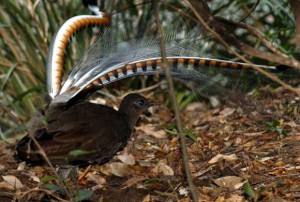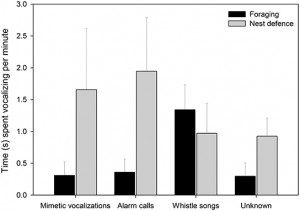Superb Lyrebirds or Superb Liarbirds? Female Oscines Possess Elaborate Mimetic Vocal Displays

Female Superb Lyrebird (Menura novaehollandiae)
https://upload.wikimedia.org/wikipedia/commons/a/a8/Lantfarku.jpg
In the bird world, it is a well-known fact that much of the elaborate vocalizations of males is due to sexual selection. If you’re a male, you better sing your little heart out to get with your girl, and that can mean incorporating vocalizations that mimic those of other birds to make yourself stand out to her. But as it turns out, male birds aren’t the only ones capable of producing complex mimetic vocalizations. Though rarely studied, researchers have wondered if female songbirds use vocalizations under the same context as males – that is, to make little songbirds (wink, wink).
Well, as fate would have it, a recent study by Dalziell and Welbergen (2016) sought an answer to the question. They found that female superb lyrebirds do, indeed, possess elaborate vocal displays, though not exactly in the same context as with males of the same species. Whereas male lyrebirds sing to get laid, female lyrebirds sing for a couple different reasons and using a couple different vocalizations, often involving mimicry.
In their study, Dalziell and Welbergen examined both the structure and context of the vocalizations of female superb lyrebirds. They predicted that if female vocalizations are simply functionless by-products of selection for song and complex mimetic vocalizations in males, then the acoustic structure should not vary predictably with ecological context, and should be similar to that of males. Alternatively, if female vocalizations are the result of distinct selective forces acting on females, then they should vary predictably with female-only activities (i.e. female-female competition and nest defense). Furthermore, the acoustic structure of female vocal displays should differ from that of males.

Figure 2. Lyrebird-specific alarm calls. The three alarm calls most commonly produced by female lyrebirds are: (A) a two-note alarm call (‘aw-kok’), (B) a guttural alarm call comprising one or more elements (one element shown here), and (C) a scream-like call (‘intense alarm call’) comprising one or more elements (two elements shown here).
In order to test their predictions, the researchers recorded breeding female lyrebirds in three different ecological contexts: 1) foraging, 2) nest defense, and 3) courtship with males. Under the foraging context, incubating or brooding females were observed foraging from a distance and their vocalizations were recorded using a hand-held microphone attached to a digital recorder. To observe nest defense, the researchers approached the individual nests of the females to band and measure the nestlings, which the female lyrebirds responded to as a threat. The individual females were sound-recorded during their visual and vocal threat displays to the approaching researchers using the same microphone and digital recorder used for the foraging context. Lastly, the role of female vocalizations during sexual interactions (courtship) was examined. This was accomplished by placing motion-sensitive camera traps at male lyrebird display mounds which, once triggered, recorded the courtship displays of the birds. The recordings of the female vocalizations were then audio-visually analyzed and categorized as either an alarm call (Figure 2), a lyrebird-specific song, or a mimetic vocalization. Mimetic vocalizations were further subdivided into either 1) predator imitations (so, imitations of likely predators of lyrebirds), 2) alarm imitations (which are imitations of the alarm calls of birds likely to be harmless to lyrebirds), or 3) non-alarm imitations (or imitations of other birds harmless to lyrebirds).
From the data analysis, Dalziell and Welbergen ultimately determined that female superb lyrebirds regularly produce structurally and acoustically complex vocal sounds, and that the structure of the vocalizations varied significantly with context. For instance, while foraging, the females mostly produced a complex lyrebird-specific song, whereas they gave lyrebird-specific alarm calls most often during nest defense. This makes sense because in lyrebirds nest defense is carried solely by the female, and offspring survival should push for strong selection pressure on nest defense. Furthermore, within their vocal displays, the females also incorporated a variety of mimetic vocalizations, including imitations of the calls of dangerous predators, and of alarm calls and songs of other harmless birds (Figure 5). Together, their results support the hypothesis that complex female vocalizations play a role in nest defense and mediate female-female competition for breeding territories, and so are not just a by-product of selection for vocal complexity in males.

Figure 5. The time (seconds ± SE) that females spent producing the four vocalization types (x-axis) in the foraging (black bars; nfemale = 10) and nest defense contexts (gray bars; nfemale = 8). Means and standard errors were calculated from raw data.
This study is among the first to look at female vocalizations in different ecological contexts. Not only do the results highlight the hidden complexity of female vocalizations in songbirds, they also suggest that male and female passerines are under distinctly different selection pressures for vocal complexity, a notion that has been previously overlooked. Specifically, the study suggests that sexual differences between males and females may lie more in what is learned rather than in the ability to learn. Future studies with a greater focus on female vocalizations may thus provide key insights into both the mechanisms and functions of learned vocalizations, and can further elucidate the important role of vocalizations in mediating female fitness.
Reference:
Dalziell, A. H. & Welbergen, J. A. (2016). Elaborate mimetic vocal displays by female superb lyrebirds. Front. Ecol. Evol., 4:1-13. Doi: 10.3389/fevo.2016.00034
